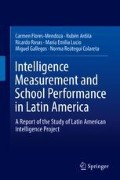Abstract
One century of intelligence research, generally performed on samples from developed countries, has shown the existence of a general model of intelligence (or g factor). In our study, we tested this model using data from the SLATINT Project. A positive manifold of correlations was found and results from SEM modeling (Structural Equation Modeling), using the total sample and each Latin American sample, indicated that a single-factor model (or g factor) fit the data adequately, i.e., a general cognitive ability influenced performance on a set of cognitive ability measures.
Access this chapter
Tax calculation will be finalised at checkout
Purchases are for personal use only
References
Bentler, P.M. (1985). Theory and implementation of EQS. A structural equations program. Los Angeles: BMDP Statistical Software.
Carroll, J. B. (1993). Human cognitive abilities: A survey of factor-analytic studies. New York: Cambridge University Press.
Detterman, D. K., & Daniel, M. H. (1989). Correlations of mental tests with each other and with cognitive variables are highest for low-IQ groups. Intelligence, 13, 349–359.
Floyd, R. G., Shands, E. I., Rafael, F. A., Bergeron, R., & McGrew, K. S. (2009). The dependability of general-factor loadings: the effects of factor-extraction methods, test battery composition, test battery size, and their interactions. Intelligence, 37, 453–465.
Gardner, H. (1983). Frames of mind: The theory of multiple intelligences. Nueva York, EUA: Basic Books.
Gottfredson, L. (1997). Why g matters: The complexity of every life. Intelligence, 24, 79–132.
Jamshidian, M., & Bentler, P. M. (1999). ML estimation of mean and covariance structures with missing data using complete data routines. Journal of Educational and Behavioral Statistics, 24, 21–41.
Jensen, A., & Weng, L. (1994). What is a good g? Intelligence, 18, 231–258.
Jensen, A. (2008). Book review. Intelligence, 36, 96–97.
Jensen, A. R. (1998). The g factor. London: Praeger.
Johnson, W., Bouchard, T. J., Krueger, R. F., McGue, M., & Gottesman, I. I. (2004). Just one g: consistent results from three test batteries. Intelligence, 32, 95–107.
Ree, M. J., & Earles, J. A. (1991). The stability of g across different methods of estimation. Intelligence, 15, 271–278.
Spearman, C., & Jones, L. W. (1950). Human ability: A continuation of the abilities of man. London: Macmillan.
Spearman, C. (1927). The abilities of man: Their nature and measurement. London: Macmillan.
Sternberg, R. J. (1985). Beyond IQ: A triarchic theory of human intelligence. New York: Cambridge University Press.
Sternberg, R. J. (2003). “My house is a very very fine house”—But it is not the only house. In H. Nyborg (Ed.), The scientific study of general intelligence. Tribute to Arthur R. Jensen. Oxford: Pergamon.
Thorndike, R. L. (1987). Stability of factor loadings. Personality and individual differences, 8, 585–586.
Yuan, K., & Bentler, P.M. (2000). Three likelihood-based methods for mean and covariance structure analysis with nonnormal missing data. Sociological Methodology, 30, 165–200.
Author information
Authors and Affiliations
Rights and permissions
Copyright information
© 2018 Springer International Publishing AG, part of Springer Nature
About this chapter
Cite this chapter
Flores-Mendoza, C., Ardila, R., Rosas, R., Lucio, M.E., Gallegos, M., Reátegui Colareta, N. (2018). Cognitive Factor Structure: The g Factor. In: Intelligence Measurement and School Performance in Latin America. Springer, Cham. https://doi.org/10.1007/978-3-319-89975-6_2
Download citation
DOI: https://doi.org/10.1007/978-3-319-89975-6_2
Published:
Publisher Name: Springer, Cham
Print ISBN: 978-3-319-89974-9
Online ISBN: 978-3-319-89975-6
eBook Packages: Behavioral Science and PsychologyBehavioral Science and Psychology (R0)

